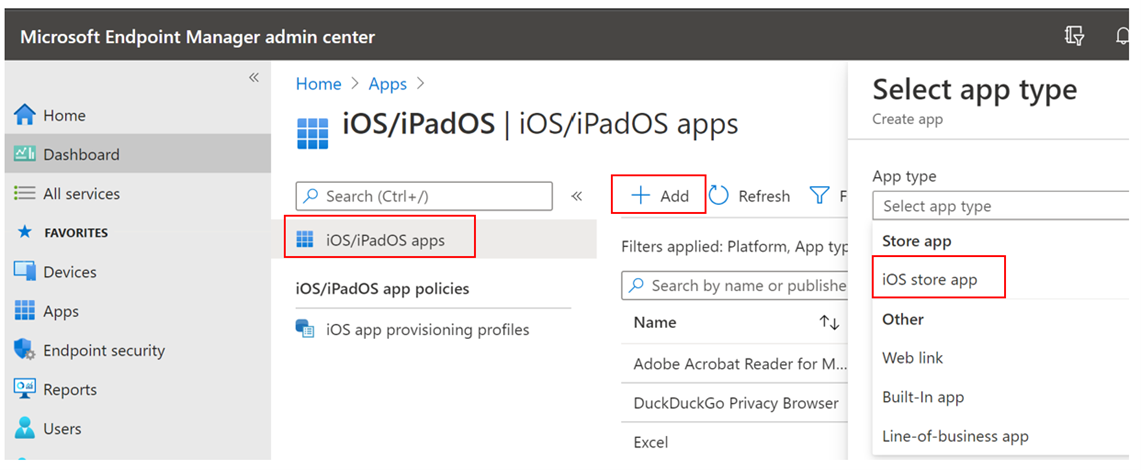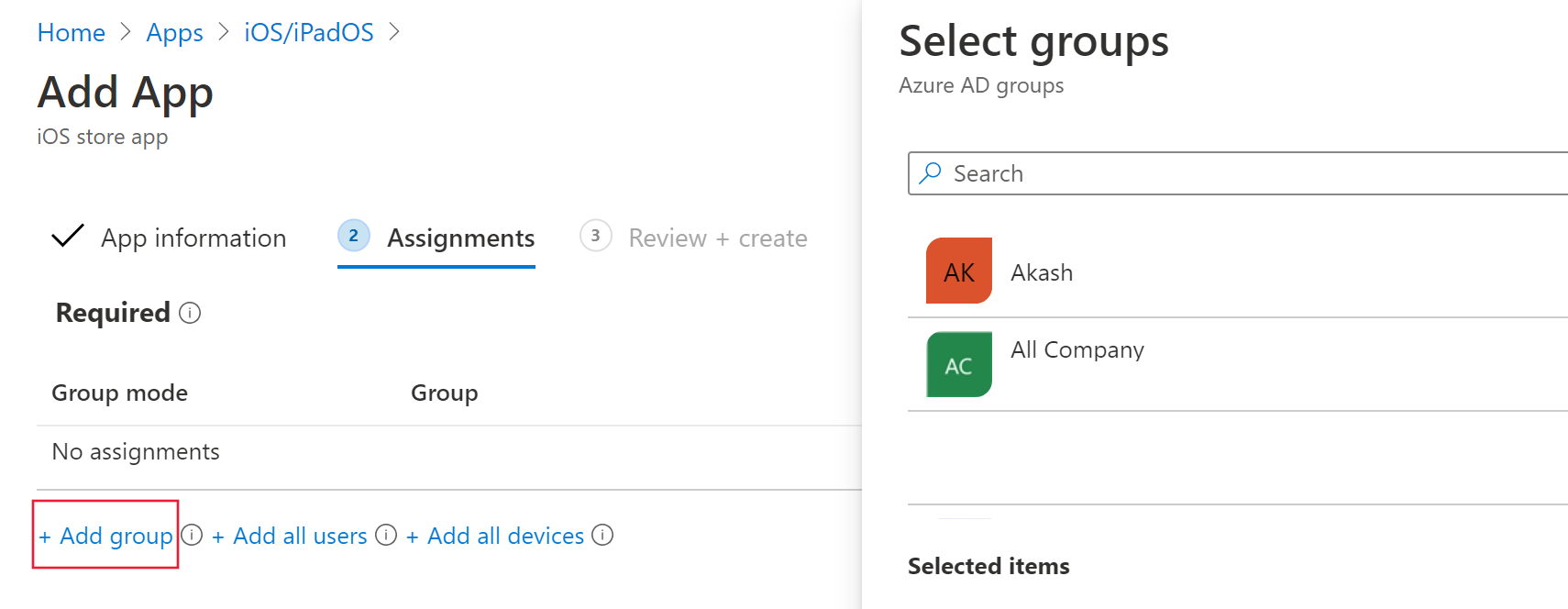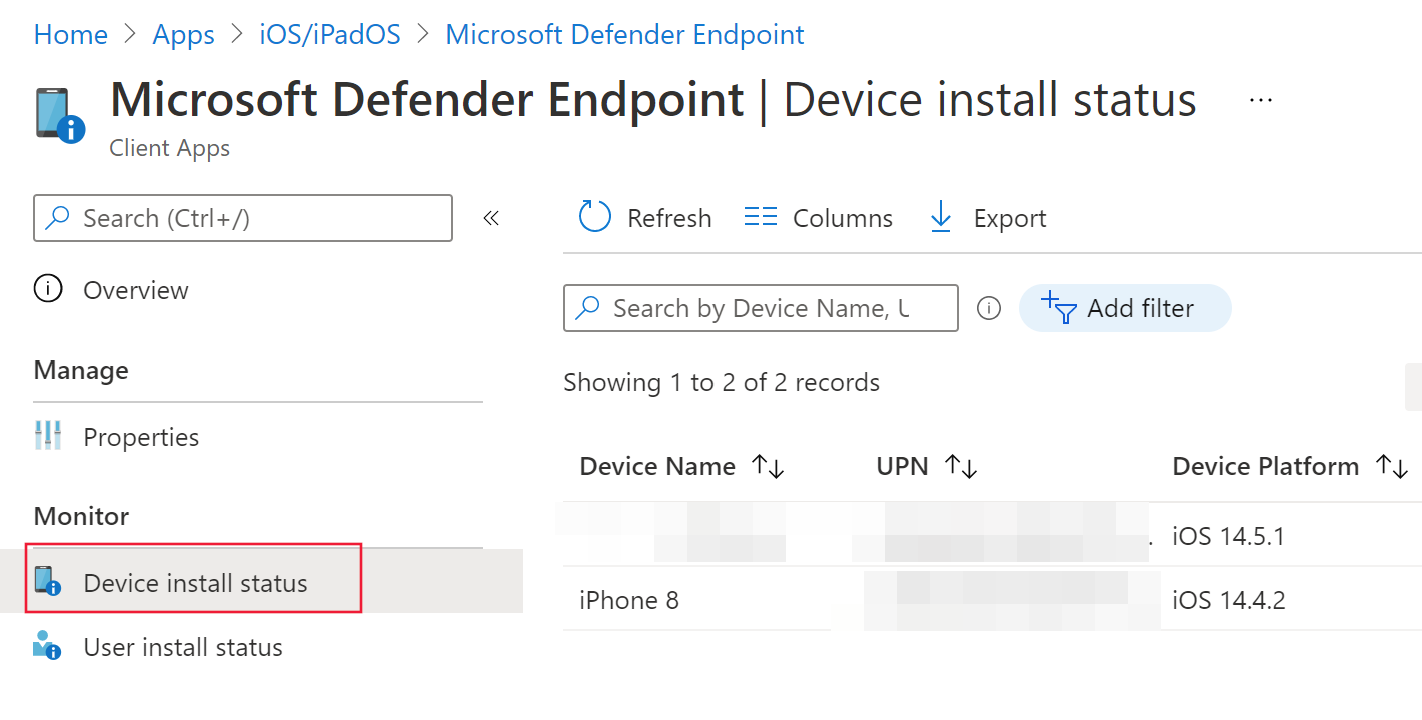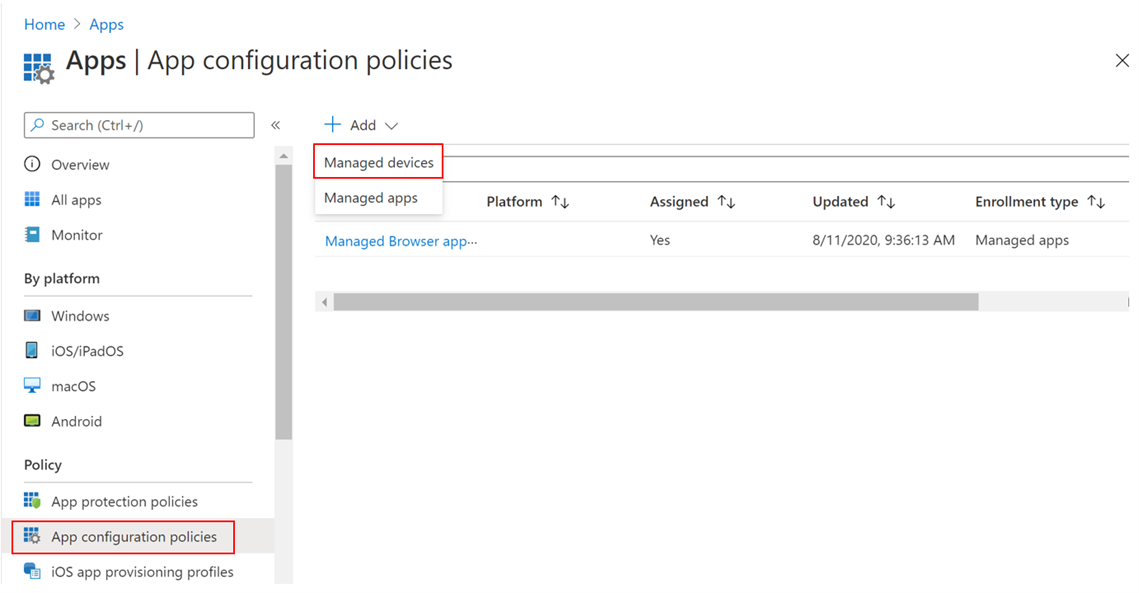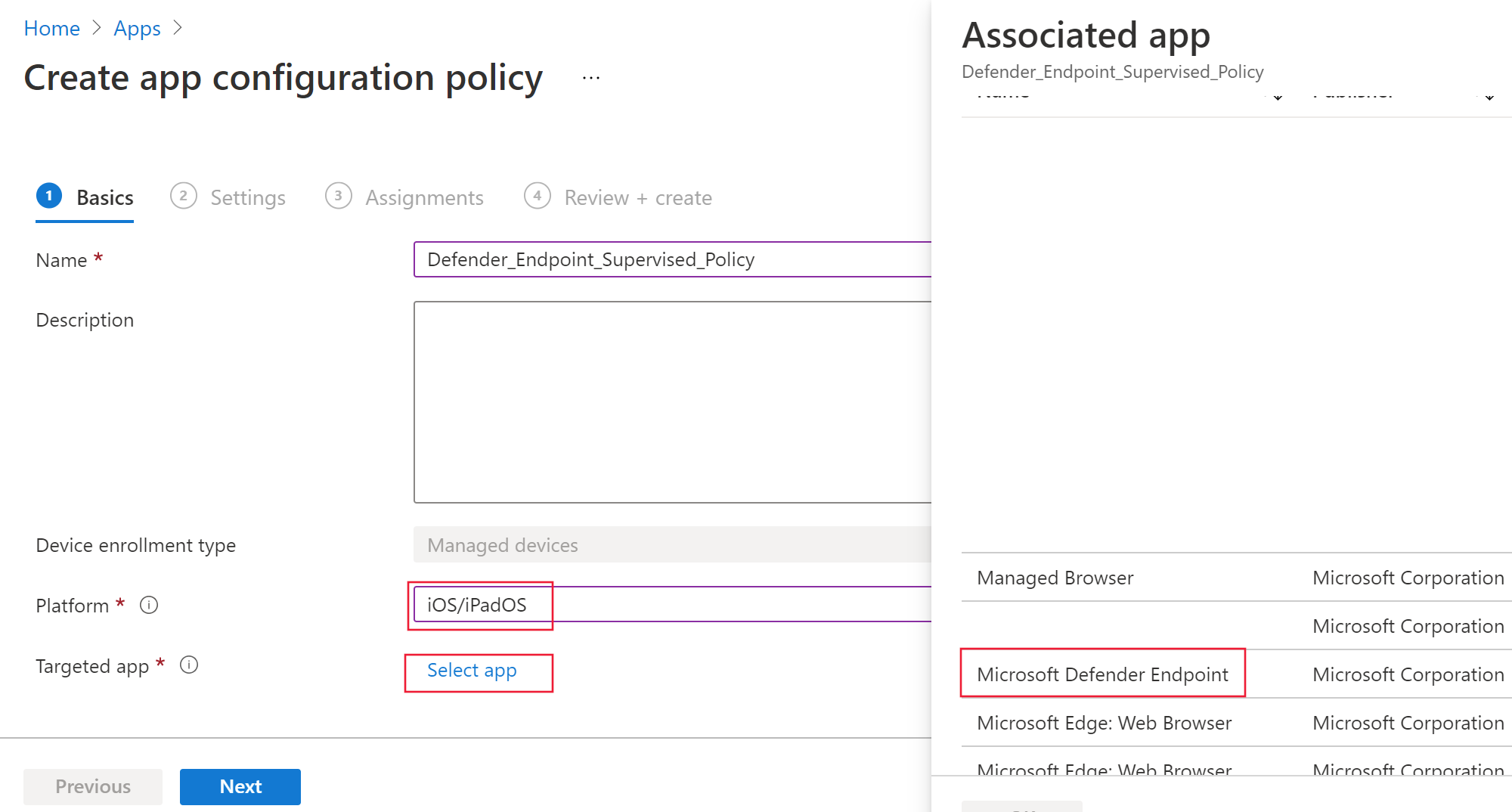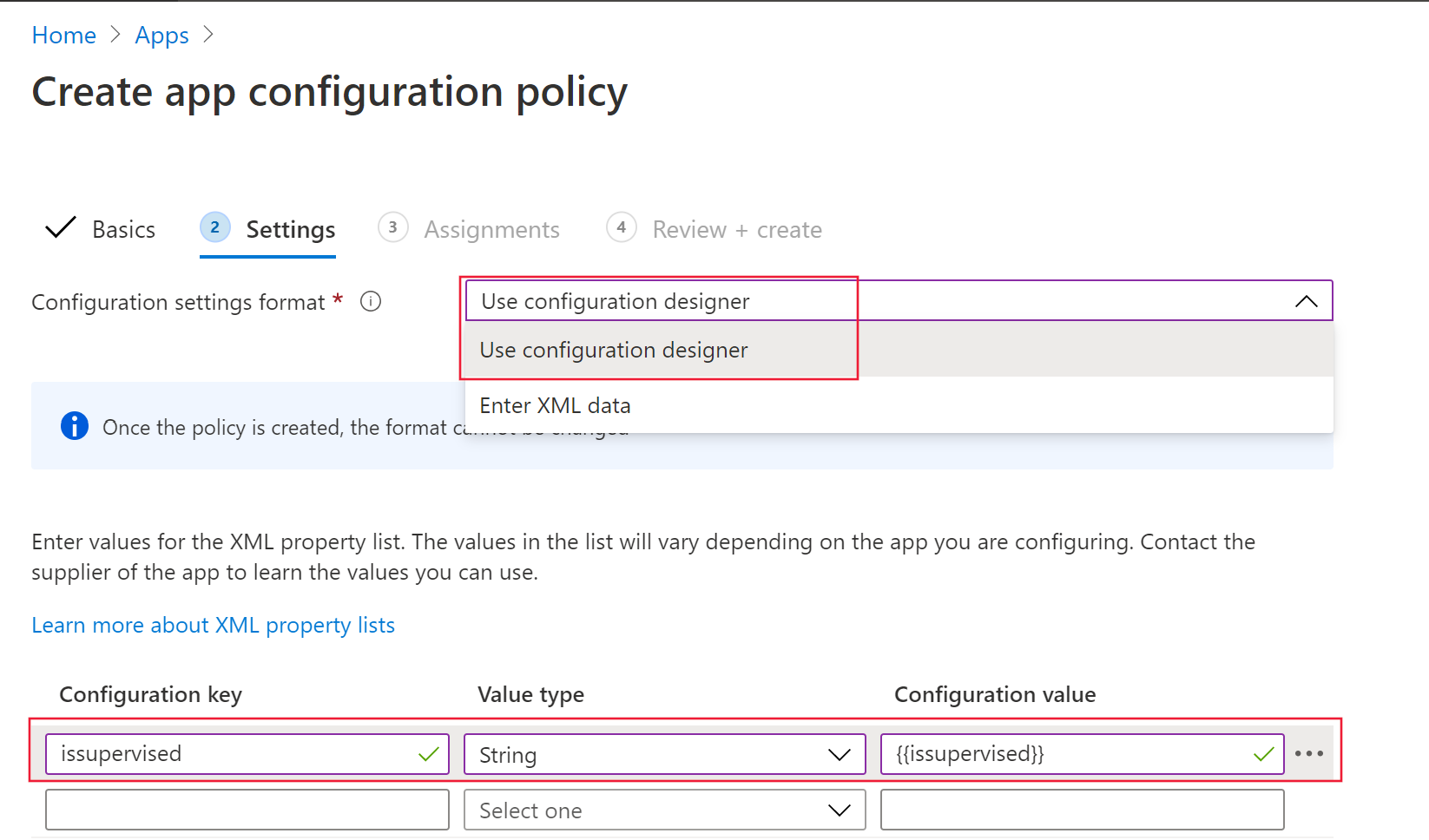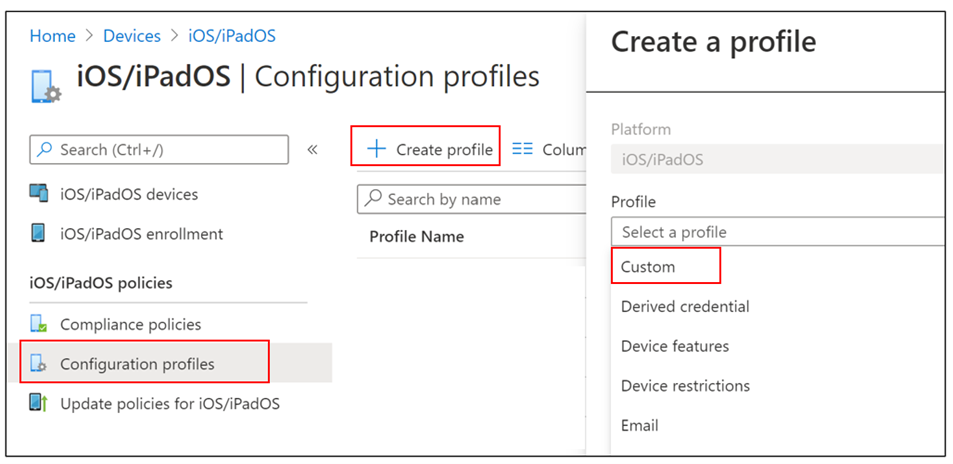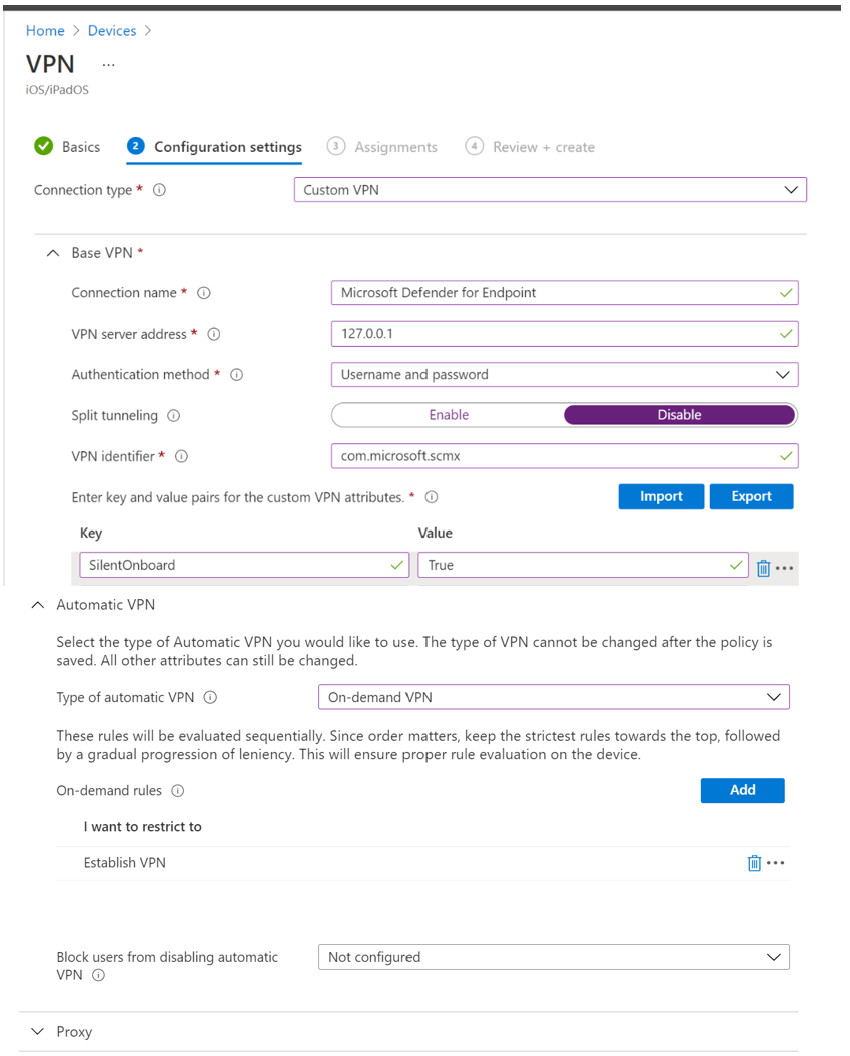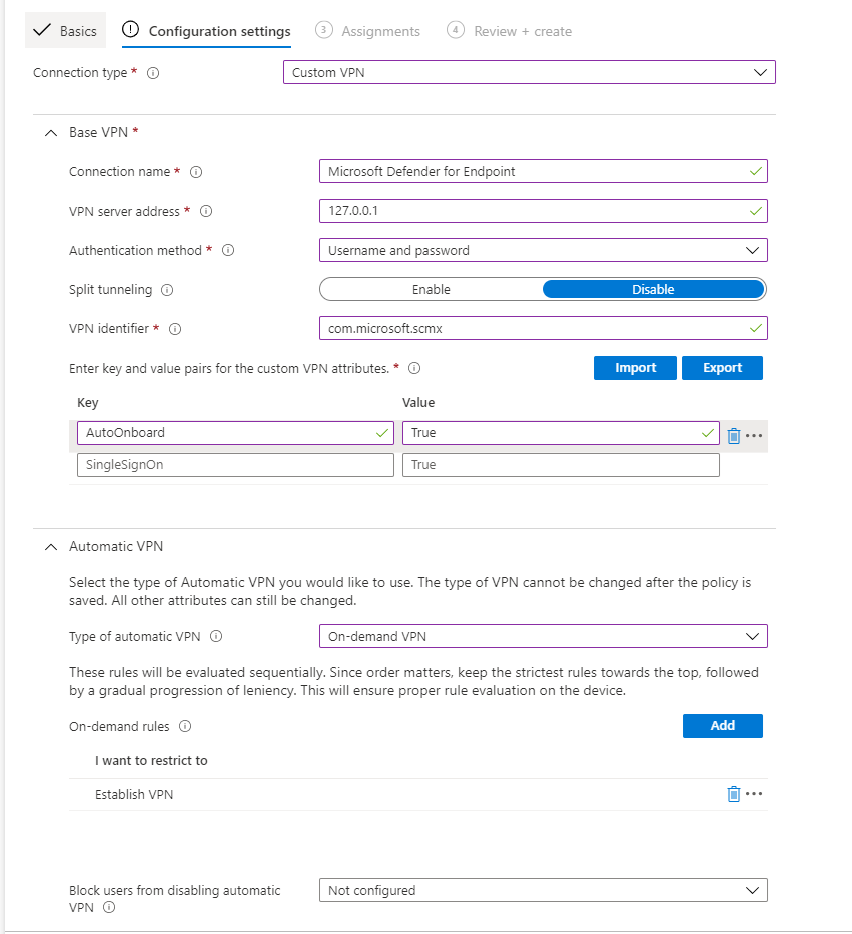Deploy Microsoft Defender for Endpoint on iOS with Microsoft Intune
Applies to:
- Microsoft Defender for Endpoint Plan 1
- Microsoft Defender for Endpoint Plan 2
- Microsoft Defender XDR
Want to experience Defender for Endpoint? Sign up for a free trial.
This topic describes deploying Defender for Endpoint on iOS on Microsoft Intune Company Portal enrolled devices. For more information about Microsoft Intune device enrollment, see Enroll iOS/iPadOS devices in Intune.
Before you begin
Ensure you have access to the Microsoft Intune admin center.
Ensure iOS enrollment is done for your users. Users need to have a Defender for Endpoint license assigned in order to use Defender for Endpoint on iOS. Refer to Assign licenses to users for instructions on how to assign licenses.
Ensure the end users have company portal app installed, signed inC, and enrollment completed.
Note
Microsoft Defender for Endpoint on iOS is available in the Apple App Store.
This section covers:
Deployment steps (applicable for both Supervised and Unsupervised devices)- Admins can deploy Defender for Endpoint on iOS via Microsoft Intune Company Portal. This step isn't needed for VPP (volume purchase) apps.
Complete deployment (only for Supervised devices)- Admins can select to deploy any one of the given profiles.
- Zero touch (Silent) Control Filter - Provides Web Protection without the local loopback VPN and also enables silent onboarding for users. App is automatically installed and activated without the need for user to open the app.
- Control Filter - Provides Web Protection without the local loopback VPN.
Automated Onboarding setup (only for Unsupervised devices) - Admins can automate the Defender for Endpoint onboarding for users in two different ways:
- Zero touch (Silent) Onboarding - App is automatically installed and activated without the need for users to open the app.
- Auto Onboarding of VPN - Defender for Endpoint VPN profile is automatically set up without having the user to do so during onboarding. This step isn't recommended in Zero touch configurations.
User Enrollment setup (only for Intune User Enrolled devices) - Admins can deploy and configure the Defender for Endpoint app on the Intune User Enrolled devices also.
Complete onboarding and check status - This step is applicable for all enrollment types to ensure app is installed on the device, onboarding is completed, and device is visible in the Microsoft Defender portal. It can be skipped for the zero touch (silent) onboarding.
Deployment steps (applicable for both Supervised and Unsupervised devices)
Deploy Defender for Endpoint on iOS via Microsoft Intune Company Portal.
Add iOS store app
In the Microsoft Intune admin center, go to Apps > iOS/iPadOS > Add > iOS store app and select Select.
On the Add app page, select Search the App Store and type Microsoft Defender in the search bar. In the search results section, select Microsoft Defender and select Select.
Select iOS 15.0 as the Minimum operating system. Review the rest of information about the app and select Next.
In the Assignments section, go to the Required section and select Add group. You can then choose the user groups that you would like to target Defender for Endpoint on iOS app. Click Select and then Next.
Note
The selected user group should consist of Microsoft Intune enrolled users.
In the Review + Create section, verify that all the information entered is correct and then select Create. In a few moments, the Defender for Endpoint app should be created successfully, and a notification should show up at the top-right corner of the page.
In the app information page that is displayed, in the Monitor section, select Device install status to verify that the device installation has completed successfully.
Complete deployment for supervised devices
The Microsoft Defender for Endpoint on iOS app has specialized ability on supervised iOS/iPadOS devices, given the increased management capabilities provided by the platform on these types of devices. It can also provide Web Protection without setting up a local VPN on the device. This gives end-users a seamless experience while still being protected from phishing and other web-based attacks.
Admins can use the following steps to configure supervised devices.
Configure Supervised Mode via Microsoft Intune
Configure the supervised mode for Defender for Endpoint app through an App configuration policy and Device configuration profile.
App configuration policy
Note
This app configuration policy for supervised devices is applicable only to managed devices and should be targeted for ALL managed iOS devices as a best practice.
Sign in to the Microsoft Intune admin center and go to Apps > App configuration policies > Add. Select Managed devices.
In the Create app configuration policy page, provide the following information:
- Policy Name
- Platform: Select iOS/iPadOS
- Targeted app: Select Microsoft Defender for Endpoint from the list
In the next screen, select Use configuration designer as the format. Specify the following properties:
- Configuration Key:
issupervised - Value type: String
- Configuration Value:
{{issupervised}}
- Configuration Key:
Select Next to open the Scope tags page. Scope tags are optional. Select Next to continue.
On the Assignments page, select the groups that receive this profile. For this scenario, it's best practice to target All Devices. For more information on assigning profiles, see Assign user and device profiles.
When deploying to user groups, a user must sign in to a device before the policy applies.
Click Next.
On the Review + create page, when you're done, choose Create. The new profile is displayed in the list of configuration profiles.
Device configuration profile (Control Filter)
Note
For devices that run iOS/iPadOS (in Supervised Mode), there is custom .mobileconfig profile, called the ControlFilter profile available. This profile enables Web Protection without setting up the local loopback VPN on the device. This gives end-users a seamless experience while still being protected from phishing and other web-based attacks.
However, the ControlFilter profile does not work with Always-On VPN (AOVPN) due to platform restrictions.
Admins deploy any one of the given profiles.
Zero touch (Silent) Control Filter - This profile enables silent onboarding for users. Download the config profile from ControlFilterZeroTouch.
Control Filter - Download the config profile from ControlFilter.
Once the profile has been downloaded, deploy the custom profile. Follow the steps below:
Navigate to Devices > iOS/iPadOS > Configuration profiles > Create Profile.
Select Profile Type > Templates and Template name > Custom.
Provide a name of the profile. When prompted to import a Configuration profile file, select the one downloaded from the previous step.
In the Assignment section, select the device group to which you want to apply this profile. As a best practice, this should be applied to all managed iOS devices. Select Next.
Note
Device Group creation is supported in both Defender for Endpoint Plan 1 and Plan 2.
On the Review + create page, when you're done, choose Create. The new profile is displayed in the list of configuration profiles.
Automated Onboarding setup (only for Unsupervised devices)
Admins can automate the Defender onboarding for users in two different ways with Zero touch(Silent) Onboarding or Auto Onboarding of VPN.
Zero-touch (Silent) onboarding of Microsoft Defender for Endpoint
Note
Zero-touch cannot be configured on iOS devices that are enrolled without user affinity (user-less devices or shared devices).
Admins can configure Microsoft Defender for Endpoint to deploy and activate silently. In this flow, the administrator creates a deployment profile and the user is simply notified of the installation. Defender for Endpoint is automatically installed without the need for the user to open the app. Follow the steps below to set up zero-touch or silent deployment of Defender for Endpoint on enrolled iOS devices:
In the Microsoft Intune admin center, go to Devices > Configuration Profiles > Create Profile.
Choose Platform as iOS/iPadOS, Profile type as Templates and Template name as VPN. Select Create.
Type a name for the profile and select Next.
Select Custom VPN for Connection Type and in the Base VPN section, enter the following:
- Connection Name = Microsoft Defender for Endpoint
- VPN server address = 127.0.0.1
- Auth method = "Username and password"
- Split Tunneling = Disable
- VPN identifier = com.microsoft.scmx
- In the key-value pairs, enter the key SilentOnboard and set the value to True.
- Type of Automatic VPN = On-demand VPN
- Select Add for On Demand Rules and select I want to do the following = Connect VPN, I want to restrict to = All domains.
- To mandate that VPN can't be disabled in users device, Admins can select Yes from Block users from disabling automatic VPN. By default, it's not configured and users can disable VPN only in the Settings.
- To allow Users to Change the VPN toggle from within the app, add EnableVPNToggleInApp = TRUE, in the key-value pairs. By default, users can't change the toggle from within the app.
Select Next and assign the profile to targeted users.
In the Review + Create section, verify that all the information entered is correct and then select Create.
Once the above configuration is done and synced with the device, the following actions take place on the targeted iOS device(s):
- Microsoft Defender for Endpoint will be deployed and silently onboarded and the device will be seen in the Defender for Endpoint portal.
- A provisional notification will be sent to the user device.
- Web Protection and other features will be activated.
Note
- Zero touch setup can take up to 5 minutes to complete in the background.
- For supervised devices, admins can set up Zero touch onboarding with the ZeroTouch Control Filter Profile. Defender for Endpoint VPN Profile will not be installed on the device and Web protection will be provided by the Control Filter Profile.
Auto-Onboarding of VPN profile (Simplified Onboarding)
Note
This step simplifies the onboarding process by setting up the VPN profile. If you are using Zero touch, you do not need to perform this step.
For unsupervised devices, a VPN is used to provide the Web Protection feature. This is not a regular VPN and is a local/self-looping VPN that does not take traffic outside the device.
Admins can configure auto-setup of VPN profile. This will automatically set up the Defender for Endpoint VPN profile without having the user to do so while onboarding.
In the Microsoft Intune admin center, go to Devices > Configuration Profiles > Create Profile.
Choose Platform as iOS/iPadOS and Profile type as VPN. Click Create.
Type a name for the profile and click Next.
Select Custom VPN for Connection Type and in the Base VPN section, enter the following:
Connection Name = Microsoft Defender for Endpoint
VPN server address = 127.0.0.1
Auth method = "Username and password"
Split Tunneling = Disable
VPN identifier = com.microsoft.scmx
In the key-value pairs, enter the key AutoOnboard and set the value to True.
Type of Automatic VPN = On-demand VPN
Select Add for On Demand Rules and select I want to do the following = Connect VPN, I want to restrict to = All domains.
To require that VPN cannot be disabled on a users' device, Admins can select Yes from Block users from disabling automatic VPN. By default, this setting not configured and users can disable VPN only in the Settings.
To allow Users to Change the VPN toggle from within the app, add EnableVPNToggleInApp = TRUE, in the key-value pairs. By default, users cannot change the toggle from within the app.
Click Next and assign the profile to targeted users.
In the Review + Create section, verify that all the information entered is correct and then select Create.
User Enrollment setup (only for Intune User Enrolled devices)
Microsoft Defender iOS app can be deployed on the Intune User Enrolled devices using the following steps.
Admin
Set up User Enrollment Profile in Intune. Intune supports account driven Apple User Enrollment and Apple User Enrollment with Company Portal. Read more about the comparison of the two methods and select one.
Set up SSO Plugin. Authenticator app with SSO extension is a pre-requisite for user enrollment in an iOS device.
- Create is Device configuration Profile in Intune- Configure iOS/iPadOS Enterprise SSO plug-in with MDM | Microsoft Learn.
- Ensure to add these two keys in the above configuration:
- App bundle ID: Include the Defender App bundle ID in this list com.microsoft.scmx
- Additional configuration: Key - device_registration ; Type - String ; Value- {{DEVICEREGISTRATION}}
Set up the MDM Key for User Enrollment.
- In Intune, go to Go to Apps > App configuration policies > Add > Managed devices
- Give the policy a name, select Platform > iOS/iPadOS,
- Select Microsoft Defender for Endpoint as the target app.
- In Settings page, select Use configuration designer and add UserEnrolmentEnabled as the key, value type as String, value as True.
Admin can push Defender as a required VPP app from Intune.
End User
Defender app is installed into the user's device. User signs in and completes the onboarding. Once the device is successfully onboarded, it will be visible in the Defender Security Portal under Device Inventory.
Supported features and limitations
- Supports all the current capabilities of Defender for Endpoint iOS like – Web protection, Network Protection, Jailbreak detection, Vulnerabilities in OS and Apps, Alerting in Defender Security Portal and Compliance policies.
- Zero touch (silent) deployment and auto onboarding of VPN is not supported with User Enrollment since admins cannot push a device wide VPN profile with User Enrollment.
- For vulnerability management of apps, only apps in the work profile will be visible.
- It can take up to 10 minutes for newly onboarded devices to become compliant if targeted by compliance policies.
- Read more on the User Enrollment limitations and capabilities.
Complete onboarding and check status
Once Defender for Endpoint on iOS has been installed on the device, you will see the app icon.
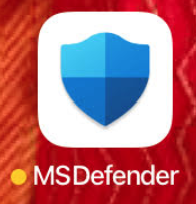
Tap the Defender for Endpoint app icon (MSDefender) and follow the on-screen instructions to complete the onboarding steps. The details include end-user acceptance of iOS permissions required by Defender for Endpoint on iOS.
Note
Skip this step if you configure zero touch (silent) onboarding. Manually launching application is not necessary if zero touch (silent) onboarding is configured.
Upon successful onboarding, the device will start showing up on the Devices list in the Microsoft Defender portal.
Next Steps
- Configure app protection policy to include Defender for Endpoint risk signals (MAM)
- Configure Defender for Endpoint on iOS features
Tip
Do you want to learn more? Engage with the Microsoft Security community in our Tech Community: Microsoft Defender for Endpoint Tech Community.
